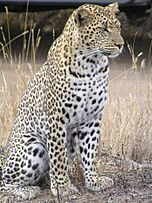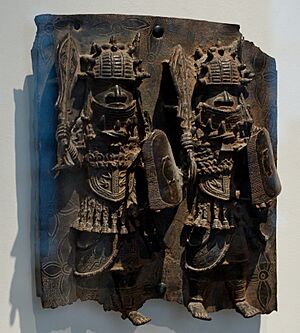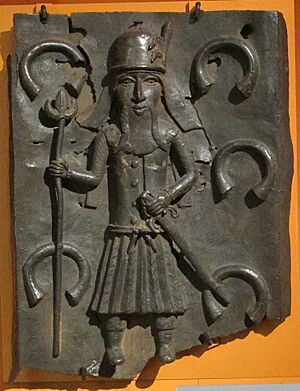Kingdom of Benin facts for kids
Quick facts for kids
Kingdom of Benin
Arriọba Ẹ̀dó
|
|||||||||||
|---|---|---|---|---|---|---|---|---|---|---|---|
| 1180–1897 | |||||||||||
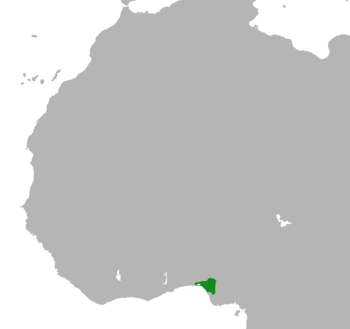
The extent of Benin in 1625
|
|||||||||||
| Capital | Edo (now Benin City) |
||||||||||
| Common languages | Edo, Yoruba and Igbo | ||||||||||
| Religion | Edo Religion, Catholic Christianity | ||||||||||
| Government | Monarchy | ||||||||||
| Oba | |||||||||||
|
• 1180–1246 (first)
|
Eweka I | ||||||||||
|
• 1888–1897 (last)
|
Ovonramwen | ||||||||||
| History | |||||||||||
|
• Established
|
1180 | ||||||||||
|
• Annexed by the United Kingdom
|
1897 | ||||||||||
|
|||||||||||
| Today part of | Nigeria | ||||||||||
The Kingdom of Benin, also known as the Edo Kingdom, was a powerful kingdom in what is now southern Nigeria. It is important to know that it is not connected to the modern country of Benin, which used to be called Dahomey. The capital city of the Kingdom of Benin was Edo, which is now known as Benin City in Edo State, Nigeria.
The Kingdom of Benin was one of the oldest and most advanced states in West Africa. It grew from an earlier kingdom called Igodomigodo around the 11th century AD. The kingdom lasted until the British Empire took control in 1897.
In the 15th and 16th centuries, the kingdom was very successful. It grew its land, traded with European countries, and created amazing art. This art included pieces made from bronze, carved ivory, and other materials.
Contents
Early History of Benin
Around 500 AD, people in the Benin area were mostly farmers. However, hunting and gathering food were still important. By this time, they also knew how to use iron.
Benin City (once called Edo) started to grow around 1000 AD. It was built in a forest, which made it easy to defend. The thick trees and narrow paths helped protect the city from attacks. The rainforest also provided many resources. People could find fish, animals to hunt, leaves for roofs, plants for medicine, and wood for building boats.
The first name of the Benin Kingdom was Igodomigodo. Its rulers were called Ogiso, which means "ruler of the sky." There were about 36 known Ogiso rulers. They began using special staffs called Ada and Eben as symbols of their power around 16 AD.
Growth of the Kingdom
From 850 AD, a series of walls showed how the city of Benin grew. The ruler, Oba Ewuare, ordered the building of an inner wall around his palace. He also built a 7-mile (11 km) long earthen wall with a 20-foot (6 m) deep moat.
Archaeologists like Graham Connah studied these walls in the 1960s. They estimated that building them would have taken a huge number of workers. Oba Ewuare also added large roads and nine strong gates. Digs in Benin City show that it was already a busy place around 1200–1300 CE.
In 1440, Oba Ewuare, also known as Ewuare the Great, became king. He made the kingdom much larger. It was around this time that the capital city became known as Ubinu. The Portuguese arrived in 1485 and called it Benin. The city then became known as Benin City.
Oba Ewuare is famous for turning Benin City from a military fort into a city-state. He used this strong base to launch military campaigns. These campaigns expanded the kingdom from its original Edo-speaking lands. Archaeologists also found a huge network of rural earthen walls. These walls were between 4,000 to 8,000 miles (6,400 to 12,900 km) long. They would have taken hundreds of years to build and were likely used to mark out land for towns.
In the early 16th century, Oba Esigie made the kingdom even bigger towards the east. He defeated an invasion by the Igala kingdom. Benin became very strong and controlled much of what is now mid-western Nigeria. The kingdom became rich through trade, especially with areas further inland. Trading with Europeans from the late 15th century also added to Benin's wealth. They traded goods like pepper, cloth, and ivory.
After Oba Ehengbuda, who was the last warrior king in the late 16th century, the empire slowly became smaller. In the late 17th century, a civil war caused the kingdom to decline. However, in the early 18th century, Oba Ewuakpe brought back the power of the Oba. His son, Oba Akenzua, became one of the richest Obas in the kingdom's history because of trade with Europeans.
Amazing Art and Culture
The Kingdom of Benin developed a very advanced artistic culture. They were especially famous for their art made from bronze, iron, and ivory. These artworks include bronze wall plaques and life-sized bronze heads. These heads showed the Obas (kings) and Iyobas (queen mothers) of Benin. The plaques also showed people, animals, and items like ceremonial belts.
Ivory was also used to carve beautiful boxes, combs, and armlets. One of the most famous artworks is the Benin ivory mask, which shows Queen Idia. Ivory masks were worn around the waist by kings.
Benin ruled over many groups of people in the Niger Delta. These included the Western Igbo, Ijaw, Itshekiri, Isoko, and Urhobo tribes. It also controlled Eastern Yoruba tribes like Ondo and Ekiti. At its peak in the 16th century, Benin controlled trade along the entire coast. This stretched from the Western Niger Delta all the way to almost Accra in the West.
Britain and Benin
In the 19th century, Benin's economy was doing well. They traded in palm oil, textiles, and ivory. To keep its independence, the Oba slowly stopped exporting other goods from Benin. Eventually, trade was only in palm oil.
By the late 1800s, Britain wanted a closer relationship with Benin. British officials wanted to control trade in the area. They were interested in Benin's palm oil, kola nut, ivory, and rubber.
Several attempts were made to create a treaty between Benin and the United Kingdom. However, these efforts did not work. The kingdom resisted becoming a British protectorate throughout the 1880s.
The Gallwey Treaty of 1892
In 1892, Henry Gallwey, a British Vice-Consul, visited Benin City. He hoped to open up trade and eventually make Benin Kingdom a British protectorate. Gallwey managed to get Oba Ovonramwen and his chiefs to sign a treaty. This treaty gave Britain a reason to have more influence over the kingdom.
The treaty suggested that Oba Ovonramwen wanted Benin to become a protectorate. However, Gallwey's own notes show that the Oba was not eager to sign it. While some people say Britain's actions were for good reasons, letters from colonial officials show that money and resources were the main reasons. The treaty did not mention anything about Benin's "bloody customs" that some British officials wrote about. It only had a general statement about helping "civilization."
The British Expedition of 1897
In 1897, a British group went to Benin from the Oil Rivers Protectorate. They said they wanted to talk about a trade agreement. The leader, James Robert Phillips, had asked his superiors for permission to lead an armed group to remove the Oba. But he left for Benin City before getting a reply.
The Oba's generals thought this was an attempt to remove the Oba. They ordered an attack on the British group as it neared Benin City. Most of the British representatives and hundreds of African porters were killed.
In response, a large British force of 1,200 men, led by Sir Harry Rawson, attacked and captured Benin City. They destroyed parts of the city, including areas believed to belong to the chiefs responsible for the attack. A fire also burned the palace and nearby areas. The British said this fire was an accident.
The British force also took many artworks from the palace as war prizes. These included bronze figures, busts, and other sculptures, often called the "Benin Bronzes." Many of these were sold to pay for the expedition. Some went to the British Museum, but most were sold to other museums around the world. In recent years, some museums in Germany and Scotland have decided to return these bronzes to their original home.
The British took control of Benin. It became part of the Niger Coast Protectorate and later colonial Nigeria. Slavery was ended after the British took over. However, Britain also made people work without pay in Benin and other parts of southern Nigeria. In 1899, the British launched another operation against rebels who were still fighting them. The British burned towns and destroyed farms to make the rebels give up. After this, military resistance against the British in the former Kingdom of Benin stopped.
Important People of Benin
| House of Eweka |
|||
|---|---|---|---|
| Parent House: | Oodua | ||
| Titles: | * Oba of Benin
|
||
| Founder: | Oranmiyan | ||
| Current Head: | Ewuare II | ||
| Cadet Branches: | * Akenzua (Benin)
|
||
Here are some important people from the Kingdom of Benin:
- Queen Idia was the wife of Oba Ozolua around 1481 AD. She was a famous warrior. She helped her son, Esigie, win battles with her advice and knowledge. An ivory carving of her face became the symbol for FESTAC in 1977.
- Emotan was a trader. She is known for starting the first primary school in the kingdom. She also helped Oba Ewuare get his throne back from his brother, Oba Uwaifiokun, around 1432 AD.
- Queen Iden was a queen during the reign of Oba Ewuape around 1700 AD. She is famous for offering herself as a sacrifice. This was to help her husband and the kingdom after a priest said it was needed to bring peace.
- General Asoro was a warrior and sword bearer for King Ovonramwen in 1897. He helped defend Benin during the 1897 British attack. A road in Benin is named "SAKPONBA" after his famous quote, "No other person should dare pass this road except the Oba."
- Chief Obasogie was a great Benin warrior who defended the kingdom. He was also a skilled blacksmith and sculptor.
Customs and Rules
Royal Burials
The kingship in Benin was passed down through families. The oldest son would become the new Oba. To become king, the eldest son had to bury his father and perform special ceremonies. If he did not complete these tasks, he might not be allowed to become king.
Mother and Son Separation
After a son became king, his mother was given the title of Iyoba (Queen Mother). She then moved to a palace outside Benin City, in a place called Uselu. The Queen Mother had a lot of power. However, she was never allowed to meet her son, the new divine ruler, again.
The Divine Oba
In Benin, the Oba was seen as a divine (god-like) being. The Oba's sacredness was the most important part of his kingship. He was surrounded by mystery and only left his palace for special events. It was once against the law, punishable by death, to say that the Oba did normal human things like eating, sleeping, or washing. People also believed the Oba had magical powers.
Benin Architecture
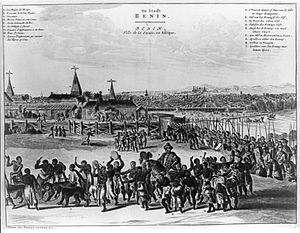
The Impluvium was a special design used in Benin architecture to collect rainwater. In noble homes, a compluvium directed rainwater into the impluvium. This also let in light and air, as these buildings did not have windows. The collected rainwater would then drain out of the house through a system under the floor.
Archaeological digs in the mid-20th century found old potsherd pavements in Benin City. These were made of broken pottery pieces laid on their edges. They date back to around the 14th century or earlier.
The Walls of Benin are a huge series of earthworks. They are made of banks and ditches, called iya in the Edo language. These walls are around present-day Benin City. There are about 9 miles (15 km) of city walls and an estimated 9,900 miles (16,000 km) in the rural areas around Benin. Some experts think the walls were built between the 13th and mid-15th centuries CE. Others suggest some parts were built even earlier, in the first millennium AD.
City Walls
Westerners have known about the Benin City walls since about 1500. The Portuguese explorer Duarte Pacheco Pereira described them briefly in his travels. He wrote that the city had no wall but was surrounded by a very wide and deep moat for defense. Archaeologist Graham Connah thinks Pereira might have been mistaken. He believes Pereira did not consider an earth bank a "wall" in the European style of his time.
Another description from around 1600 by the Dutch explorer Dierick Ruiters mentions a "very high bulwark, very thick of earth, with a very deep broad ditch." He also noted a wooden gate that was guarded.
Estimates for building the walls vary. Some suggest the main city walls could have been built quickly with a large workforce. However, these estimates might not consider how long it would take to dig the earth and pile it up. It is not known if enslaved people or other types of labor were used to build the walls.
The walls were built with a ditch and a dike. The ditch was dug to form an inner moat, and the earth removed was used to create the outer bank.
The British partly destroyed the Benin Walls in 1897 during their expedition. Today, scattered pieces of the structure remain in Edo. Locals often use these pieces for building. What is left of the wall continues to be taken down for new building projects in Nigeria.
Fred Pearce wrote in New Scientist that the walls extend for about 10,000 miles (16,000 km) in total. They cover 2,510 square miles (6,500 square kilometers) and were all dug by the Edo people. He said they are four times longer than the Great Wall of China. They also used a hundred times more material than the Great Pyramid of Cheops. He estimated they took 150 million hours of digging to build.
Military Strength
The military of Benin was well-trained and organized. The Oba of Benin was the supreme military commander. Under him were generals like the Ezomo and Iyase. They oversaw a Metropolitan Regiment in the capital and a Royal Regiment of chosen warriors who also served as bodyguards. The Queen Mother, the Iyoba, also had her own regiment called the "Queen's Own."
Most of the fighting force came from Village Regiments. These groups were called upon when needed. Foreign visitors often praised Benin's military for being well-disciplined.
Before guns were introduced in the 15th century, traditional weapons like spears, short swords, and bows were used. Blacksmiths made these weapons. Later, efforts were made to make firearms locally, but Benin still relied heavily on imported guns. In 1514 or 1516, the Oba of Benin even took a Portuguese cannon to use.
Benin's military tactics were well-planned. The Oba and his commanders would discuss strategies. They used porters, canoes for water transport, and supplies from local areas to support their missions. Moving troops by canoe was very important in the rivers and lagoons of the Niger Delta, which was a key area Benin controlled.
Fortifications were important in the region, and many military campaigns involved sieges. Benin's military earthworks are some of the largest in the world. Most sieges ended by cutting off supplies and starving the enemy until they surrendered. Sometimes, European fighters with cannons were hired to help break down town gates. For example, in 1603–04, European cannons helped Benin's warriors conquer a town near Lagos.
European Visitors
The first Europeans to reach Benin were Portuguese explorers around 1485. A strong trading relationship began. The Edo people traded enslaved people and tropical goods like ivory, pepper, and palm oil. In return, they received European goods like manillas (metal bracelets used as money) and guns. In the early 16th century, the Oba sent an ambassador to Lisbon, Portugal. The king of Portugal sent Christian missionaries to Benin City. Some people in Benin City could still speak a mix of Portuguese and local languages in the late 19th century.
The first English group came to Benin in 1553. Trade grew between Europe and Benin, focusing on ivory, palm oil, pepper, and later, enslaved people. Visitors in the 16th and 19th centuries told stories in Europe about "Great Benin." They described it as a wonderful city with grand buildings, ruled by a powerful king.
A Dutch artist made a drawing of Benin City in 1668 based on descriptions. It was published in Olfert Dapper's book, Naukeurige Beschrijvinge der Afrikaensche Gewesten. The book described the royal palace:
The king's court is square and located on the right-hand side of the city... It is about the same size as the city of Haarlem and entirely surrounded by a special wall... It is divided into many magnificent palaces, houses and apartments... The buildings are of different sizes... lined with copper casts, on which pictures of their war exploits and battles are engraved. Most of the buildings... are covered with palm leaves... and every roof is adorned with a small spired tower, on which cast copper birds are standing...
Another Dutch traveler, David van Nyendael, visited Benin in 1699. He wrote about the people of Benin:
The inhabitants of the Benin are in general a kind and polite people... Whatever might be offered to them out of politeness, will always be doubled in return... To be sure, trying to take anything from them with force or violence, would be as if one tries to reach out to the Moon and will never be left unreckoned. When it comes to trade, they are very strict... Though, when one is willing to accept these customs, they are very easy-going...
Scientists have studied the brass used to make the famous Benin plaques. They found that from the late 15th century, the metal came from the Rhineland region of Germany. This brass was sent from Germany as ring-shaped pieces. These pieces were used as money in the slave trade. People in Benin melted them down to create the Benin Bronzes.
Oral Traditions and Origins
The original people and founders of the Benin Kingdom were the Edo people. They were first ruled by the Ogiso (Kings of the Sky). They called their land Igodomigodo. The first Ogiso, Ogiso Igodo, was a popular and good ruler.
In the 12th century, a big problem happened in the palace. The crown prince, Ekaladerhan, was sentenced to death. This was because the first queen, who could not have children, changed a message from a spiritual oracle to the Ogiso. The palace messengers felt sorry for the prince and let him go free near Benin. When his father, the Ogiso, died, the Ogiso dynasty ended. The people and royal elders wanted the late king's son to rule next.
After living there for some years, the prince called a meeting. He gave up his right to rule. He said "Ile-Ibinu" in Yoruba language (meaning "land of anger"). This is how the kingdom got the name Ubinu, which the Portuguese later mispronounced as Bini. He felt that only someone born and raised in the kingdom could rule its people.
He arranged for his son, Eweka, to become king instead. Eweka was born to Erinmwinde. The prince then returned to Yorubaland. The new king, Eweka, was found to be deaf and unable to speak. So, the elders asked Oranmiyan for help. He gave them special seeds to play with, saying it would make Eweka talk. While playing, Eweka said "Owomika" (meaning "My hand has grasped it!") in the Yoruba language. This became his royal name.
This led to the tradition that future Obas of Benin would spend seven days and nights at Usama. Then, they would announce their royal names at Useh. Eweka started a new line of kings that still rules today. Oranmiyan went on to found the Oyo Empire and became its first king. He later returned to Ile-Ife and was king there. His descendants still rule in Ile Ife, Oyo, and Benin.
Even during its golden age, the Oba's rule in the empire was based on the old Ogiso tradition. This meant military protection in exchange for loyalty and taxes paid to the capital. The language and culture were not forced on everyone. The empire remained diverse, with each group keeping its own ways. However, a local duke (enogie) was often appointed by the Oba for specific ethnic areas.
See also
 In Spanish: Reino de Benín para niños
In Spanish: Reino de Benín para niños
- Art of the Kingdom of Benin
- Edo people
- Edo language
- Festac Town
- Flag of the Kingdom of Benin
- History of Nigeria
- Iyoba of Benin
- Oba of Benin
- Walls of Benin


